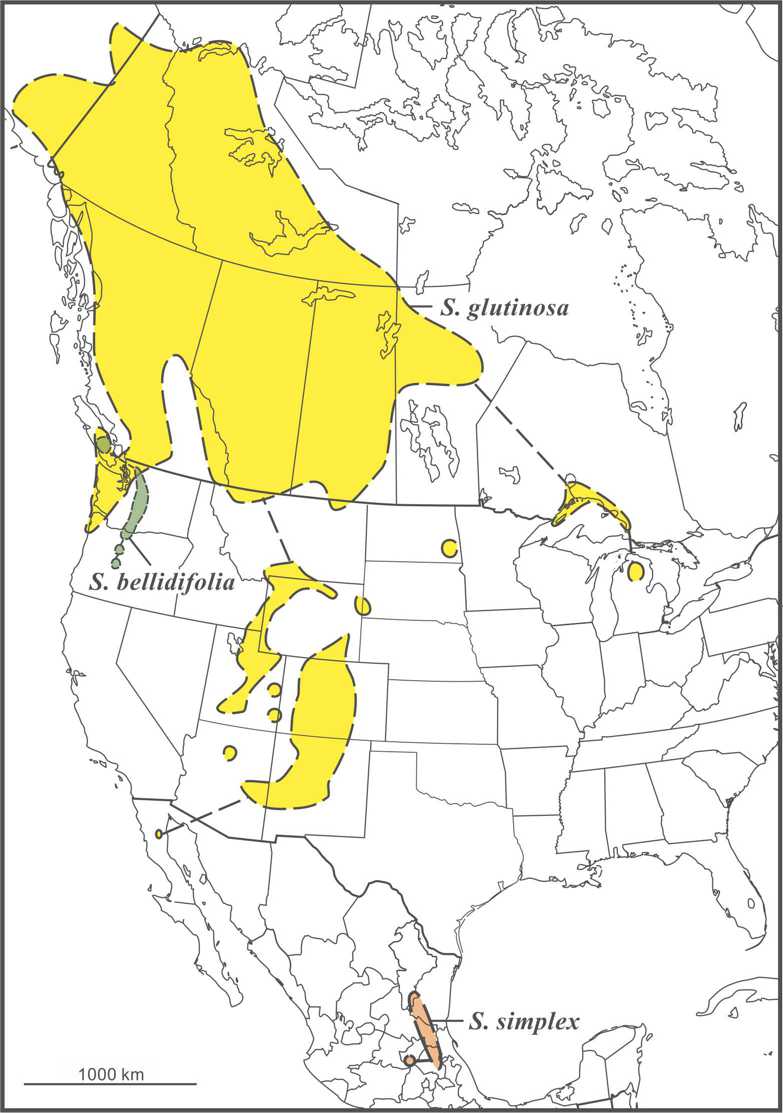Western Sticky goldenrod
Solidago glutinosa Nutt. is a predominantly western species occurring in the Rocky Mts. from Alaska to Arizona and New Mexico and in the western Prairies and Boreal Forest of Canada. Disjunct populations also occur in northern Michigan and along the north shore of Lake Superior in Ontario. With the exclusion of Mexican populations all plants treated in Flora North America (Semple and Cook, 2006) as Solidago simplex var. simplex belong in S. glutinosa as delimited here.

Solidago glutinosa has stems that are hairless to moderately short hispid-strigose (0.1-0.2 mm). Stem height varies from 10-50 (-70) cm depending upon soil, moisture and elevation. Phyllaries are rounded to obtuse apically and usually thinly resinous-viscid and somewhat shiny. The inflorescence is nearly always a short-branched array that is wand shaped. Basal and lower stem leaves taper to a winged petiolate base.
Cronquist (1947) expand the concept of the species to include western taxa in one subspecies and eastern taxa in a second. Keck (1958) went further and treated all of Cronquist's S. glutinosa within a very broadly defined S. spathulata. Ringius (1965) followed Cronquist and added another variety to S. glutinosa from Ontario. Nesom (1989) determined that S. glutinosa belonged in synonymy under S. simplex, and this was adopted by Ringius in Ringius and Semple (1991) and Semple and Cook (2006, FNA). Semple and Peirson (2013) began the splitting up of the S. simplex complex into the western Canada, US and Mexico S. simplex and split off the eastern S. chlorolepis, S. gillmanii, S. ontarioensis, S. racemosa, and S. randii as separate species. Semple et al. (2016) demonstrated that S. glutinosa and S. simplex were separate species in a multivariate analysis and noted in a figure that S. bellidifolia of the Cascade Mts. should also be treated as a separate species, although it was not discussed in any detail. Thus, S. glutinosa is now reduced to what had been var. glutinosa (or var. simplex) in the previous treatments cited. The list of synonyms includes Solidago multiradiata Ait. var. neomexicana A. Gray, Solidago neomexicana (A. Gray) Woot. & Standl. Solidago decumbens E.L. Greene, Solidago oreophila Rydb., Solidago vespertina Piper in Piper & Beattie, and Solidago yukonensis Gandoger.
There have been two cytogeography studies that have included S. glutinosa. In the first, Ringius and Semple (1987) followed Cronquist's broad definition and only counts reported as var. glutinosa belong in the species as defined here. Peirson et al. (2012) expanded the cytogeographic study to include all species of subsect. Humiles and included S. glutinosa samples under the name S. simplex var. simplex. All western and Great Plains samples were diploid (2n=18) as were most samples from northern Michigan and northern Ontario. A few samples of tetraploids (2n=36) were reported to occur in northern Michigan. All other tetraploid reports under S. simplex were for samples treated here under multiple separate species. No chromosome counts have been reported for S. simplex of Mexico.
Semple et al. (2019) presented a multivariate analysis of all 13 species of S. subsect. Humiles and compared S. bellidifolia to S. glutinosa in an analysis that provided support for recognizing the two as separate species. Solidago simplex was also supported as a separate species.
Last revised 19 May 2025 by J.C. Semple
© 2025 J.C. Semple, including all photographs unless otherwise indicated
1-4. Solidago glutinosa. 1. Habit, Semple & Brouillet 7113, Clatsop Co., Oregon. 2. Shoots, Semple & B. Semple 6548, Colorado. 3. Rosette leaves, Semple et al. 9380 WAT, Valencia Co., New Mexico. 4. Heads, Semple & Brouillet 4283 WAT, Alberta.
Nesom, G.L. 1989. Solidago simplex (Compositae: Astereae), the correct name for S. glutinosa. Phylologia 67: 155-157.
Ringius, G.S. 1985. A biosystematic study of the Solidago spathulata DC. - S. glutinosa Nutt. complex (Compositae: Astereae). Ph.D. dissertation. University of Waterloo: Waterloo, Ontario.
Ringius, G.S., and J.C. Semple. 1987. Cytogeography of the Solidago spathulata - S. glutinosa complex (Compositae: Astereae). Canad. J.Bot. 65: 2458-2462.
Peirson, J.A., A.A. Reznicek, & J.C. Semple. 2012. Polyploidy, speciation, and infraspecific cytotype variation in goldenrods: the cytogeography of Solidago subsection Humiles(Asteraceae: Astereae) in North America. Taxon: 61: 197-210.
Semple, J.C. , and J.A. Peirson. 2013. A revised nomenclature for the Solidago simplexcomplex (Asteraceae: Astereae). Phytoneuron 2013-41. 1-5.
Peirson, J.A., C.W. Dick and A.A. Reznicek. 2013. Phylogeography and polyploid evolution of North American goldenrods (Solidago subsect. Humiles, Asteraceae). J. Biogeography. 40: 1887–1898.
Semple, J.C., Y. Ma and L. Tong. 2016. On Solidago simplex
(Asteraceae: Astereae): a multivariate study including S. glutinosa, S. leiocarpa, S. multiradiata and S. spathulata. Phytoneuron 2016-87. 1-21.
Semple, J.C., K. Kornobis, A. Mazzorato, G.S. Ringius, and J.A. Peirson. 2019. A multivariate morphometric analysis of Solidago subsect. Humiles (Asteraceae: Astereae). Phytoneuron 2019-24: 1–61.







